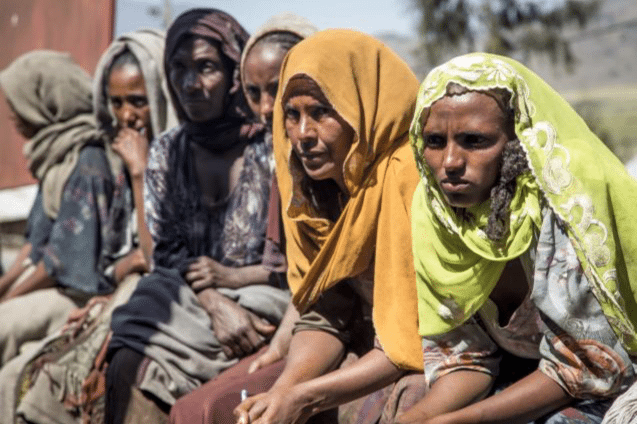In the midst of headlines on the refugee and climate crises, you may have seen mentions of a growing famine in North East Africa.
And while it’s a different crisis, the responsibility remains with the same global powers that were meeting in Paris for the climate talks and in Nairobi for the global trade talks to take action to resolve the root causes of this new crisis – the deadly combination of entrenched drought and El Niño, and inadequate public policies that protect food security and promote resilience.
Having spent the past week in Nairobi at the trade talks, I wish these global powers and their teams of negotiators could learn from the smallholder farmers that have become resilient in the face of famine, as I did on a recent visit to Ethiopia.
Despite the slow moving people in power, communities on the front lines of famine are getting on with the process of building resilience – with or without global support. I got the chance to witness them in action during a September trip to Ethiopia where I saw what they have been able to achieve.
I visited Yem. That’s right, I said, “Yem” not “Yum” – although I enjoyed the Ethiopian cuisine immensely!
It was the very end of the rainy season, so there were sudden downpours and thunderstorms every day in the late afternoon. This year, like the past few, Ethiopia has seen the rains come late and there has been less rainfall. The land has not been getting enough water, so sudden bursts of rain don’t penetrate the earth. Instead, they run off the top soil, sometimes causing more harm than good.
Despite this drought, which has caused some crop loss and depressed production overall, in September, the countryside was a brilliant patchwork of shades of green.
The famine of the 1980s which dominated US and world news – flooding us with pictures of parched and dry lands, hungry people and starving children – seems centuries away when you drive through farm after farm, crossing rolling hills and into lush forested mountains. Baboons and other monkeys play in the trees and try to steal crops and ride cows (no kidding!) provoking farmers.
While it is hard to imagine a new famine is on the rise when you travel at the end of the rains, Ethiopia has a “hungry season” from October to May. When setting out goals for ActionAid’s involvement in Yem a dozen years ago, community members wanted to be food secure. They set out two indicators of success, a reduction in the physical food gap, and a reduction in length of the hungry season.
When asked about their progress towards achieving the goal the community members celebrated. They not only reduced the hungry season – they eliminated it! Every person in the participating villages eats 2-3 meals a day, every day of the year.
There is still, at times, the need to share food to cover small food gaps, but the communities have become resilient in the face of the drought and other factors that depress harvests. Having received support to adapt the way they farm to the changing climate, breed and fatten livestock, as well as funding for a wide variety of alternative economic programs, the people in Yem are now food secure!
Even in the midst of a growing national famine, they are putting these new farming methods into practice and are able to feed themselves.
Unfortunately, Yem’s success is not shared across the country. El Niño’s hot winds are killing crops and the prolonged drought has dried up water sources in many parts of Ethiopia. Herders have been losing cattle and entire harvests have been lost. Estimates are that more than 8 million Ethiopians are in need of emergency food aid, and that number is expected to rise if the world doesn’t take action soon.
Unlike the 1980’s, when the situation was made worse by political conflict, this time the government of Ethiopia claims to be trying to meet the needs of the people, and is re-allocating parts of its budget to keep people from starving. However, the crisis has grown beyond the capacity of the government to respond. Increased public investment in agriculture and a concerted effort to build out new, climate resilient, systems of agriculture that are focused on supporting smallholder farmers are urgently needed.
I’ve witnessed the amazing changes that can happen in a community when public investments are made in women farmers so that they can adapt the way they farm in the face of climate change, organize into collectives that process their goods for market, and build alternative livelihood strategies. Farmers also need support engaging in value chains where value is calculated not only in the price of the goods for sale but also in how the food is grown and processed, and how the product has helped or hurt the earth.
The World Trade Organization meetings are another opportunity for wealthy governments to make decisions that will enable developing country governments and emerging market economies alike to protect the food security of their people.
Negotiators must end the practice of monetizing international food aid and limit dumping of agriculture products, both of which undermine local food markets and smallholder farmers like the ones in Yem. In addition we need to craft an agreement to support governments to build out food stocks, promote seed saving, invest in smallholder farmers and other food security strategies.
Here in Nairobi, in the face of famine, where drought and floods are debilitating this region, the global community has an opportunity to craft trade agreements that protect the right to food. For more people to benefit from the changes we’re seeing in Yem, we need systemic changes, and solid public food policies. The US can, and must, take the leadership to support developing countries to be able to implement these lifesaving policies in order for their people to feed themselves.

